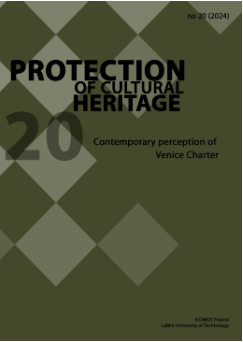Consequences of entering assets into the UNESCO List – prestige and what next?
Ewelina Kowalska
Faculty of Law and Administration of the University of Gdańsk (Poland)
https://orcid.org/0000-0001-6449-4204
Abstract
In Poland there are 70 facilities recognised as monuments of history, 14 of which are listed on the UNESCO World Heritage list. From the point of view of the effects in terms of national recognition for the historical monument, it has a prestigious meaning. Given the distinction of cultural monuments as a separately governed issue by article. 7 of the Polish Act on Antiques’ Protection and Care, a question is raised debating the ratio legis of this institution. The possibility to apply for entry onto the UNESCO list is the only result of this legal regulation. However, what is the most problematic – the entry of such historic monument onto this exclusive List also does not constitute a change in terms of the legal status of such an object. The aim of this paper is to analyse the issue of the real and effective judicial protection of, both historic monuments as well as the facilities included in the list of World Heritage.
Keywords:
historic preservation, historic monument, UNESCO World Heritage list, cultural parkReferences
Dobosz P., Uwarunkowania i możliwości wykorzystania prawa w zarządzaniu dobrami wpisanymi na Listę Światowego Dziedzictwa UNESCO zlokalizowanymi na terenie Polski [w:] Wybrane zagadnienia zarządzania dobrami UNECSO w Polsce, (red.) B. Szmygin, Warszawa 2015.
Google Scholar
Frączak K., Skuteczność ochrony pomników historii w prawie polskim [w:] Prawo ochrony zabytków, Warszawa–Gdańsk 2014.
Google Scholar
http://ww.icomos-poland.org/dokumenty-doktrynalne.html (dostęp: 15.05.2017).
Google Scholar
Jagielska-Burduk A., Nowy wizerunek dziedzictwa – między ochroną a zarządzaniem [w:] Jagielska-Burduk A., Szafrański W., Gaweł Ł., Mechanizmy prawne zarządzania dziedzictwem kultury, (red.) A. Jagielska-Burduk, Gdańsk–Warszawa 2016.
Google Scholar
Jagielska-Burduk A., Zabytek ruchomy, Warszawa 2011.
Google Scholar
Konwencja w sprawie ochrony światowego dziedzictwa kulturalnego i naturalnego, przyjęta w Paryżu dnia 16 listopada 1972 r. (Dz. U. z 1976 r. Nr 32, poz. 190).
Google Scholar
Ustawa z dnia 10 lipca 2015 r. o zmianie ustawy o ochronie zabytków i opiece nad zabytkami oraz ustawy o muzeach, Dz. U. z 2016 r., poz. 1330.
Google Scholar
Ustawa z dnia 23 lipca 2003 r. o ochronie zabytków i opiece nad zabytkami (tekst jedn. Dz. U. z 2014 r.,poz. 1446 ze zm.).
Google Scholar
Zalasińska K., Prawna ochrona zabytków nieruchomych w Polsce, Warszawa 2010.
Google Scholar
Zeidler K., Prawo ochrony dziedzictwa kultury, Warszawa 2007.
Google Scholar
Authors
Ewelina KowalskaFaculty of Law and Administration of the University of Gdańsk Poland
https://orcid.org/0000-0001-6449-4204
doktor nauk prawnych, adiunkt w Centrum Prawa Własności Intelektualnej Wydziału Prawa
i Administracji Uniwersytetu Gdańskiego. Rozprawę doktorską na temat Własność zabytku a dyskrecjonalna
władza konserwatorska obroniła z wyróżnieniem w listopadzie 2016 r. Autorka publikacji
m.in. z zakresu prawa ochrony dziedzictwa kultury. Od 2015 r. wpisana na listę adwokatów Okręgowej
Rady Adwokackiej w Gdańsku.
Statistics
Abstract views: 209PDF downloads: 169








